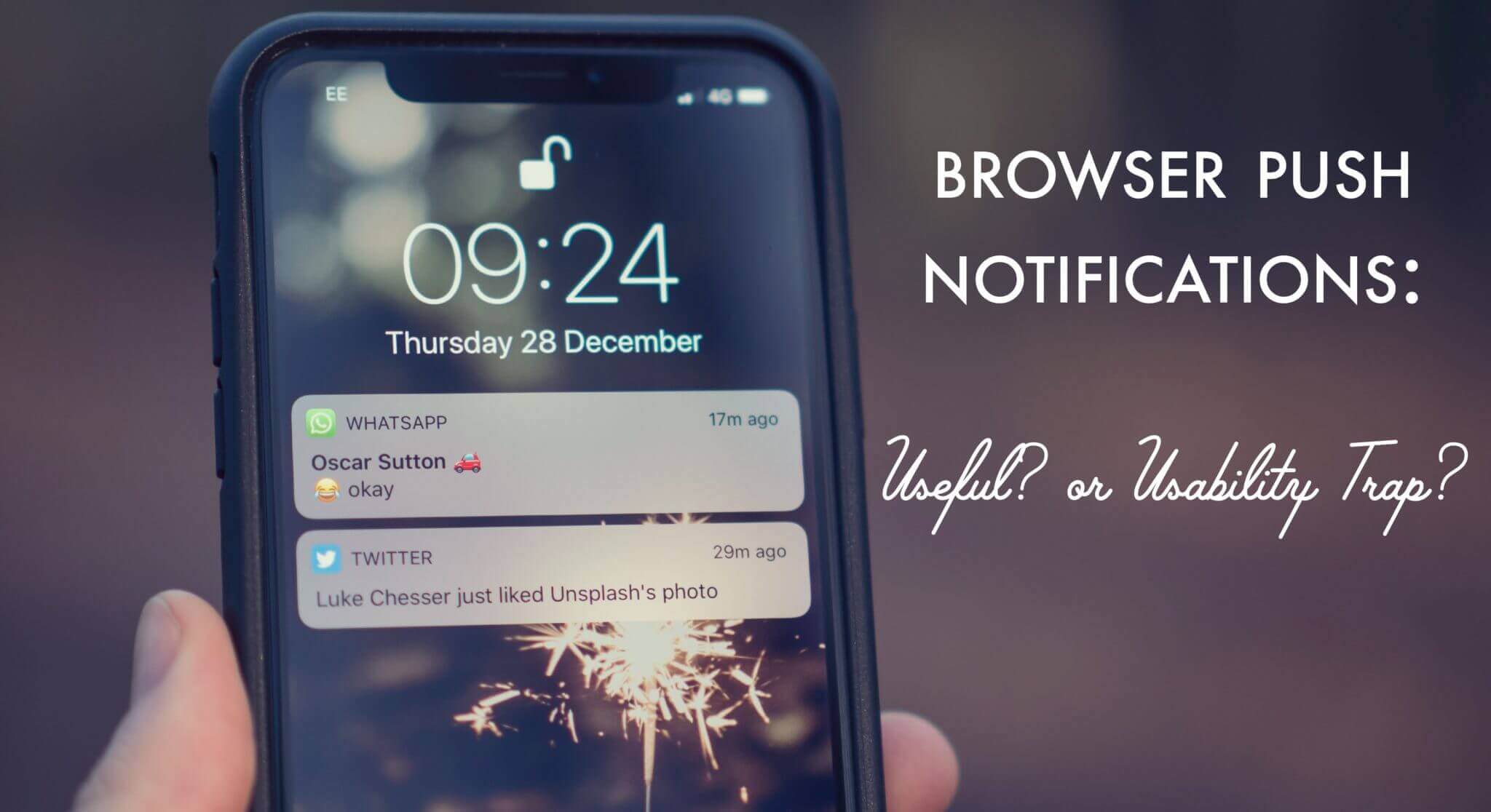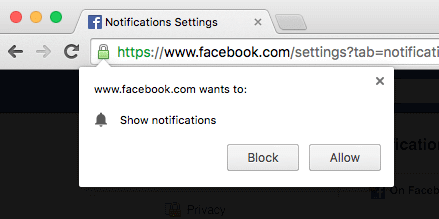
Should your website offer browser push notifications? Our look at the pros and cons.
You’ve probably noticed a rise lately in the number of websites that offer notifications. They’re simple text boxes that pop up when you visit a new website and show you an opt-in box that looks like this:

Example of a browser push notification from Facebook.
If you select “allow,” then the website (Facebook, in this instance) will start sending notifications of updates or offers, similar to the ones you’re probably used to seeing on your smartphone. If you select “block,” then Facebook will never send you notifications unless you take them off your blocked list. And if you simply click the “x” button in the corner, the notification will go away but ask you again on your next visit.
I started knowing a significant increase in the number of websites asking to send me notifications a few months ago, and I’ll admit to being a skeptic. For one, I didn’t need more distractions during my workday, and most of the websites asking to send me notifications simply weren’t interesting to me.
However, once I started to read into the subject, some of the user benefits started to come into focus. Browser push notifications aren’t for everyone, and you should make sure they’re right for your users before you start adding them to your site. But balancing the pros against the cons, they definitely come out ahead on some fronts. Let’s take a look.
Pro: They are entirely opt-in and permission-based.
The saving grace of almost any marketing tool—particularly digital ones—is that they’re opt-in. You don’t like push notifications? Don’t allow them. It’s as simple as that. When your users can easily say “no” to things they don’t want, asking permission isn’t nearly so much of an imposition.
Con: They can feel spammy.
Even though users have to give their consent to opt-in, constantly being asked to allow push notifications can be draining. From a user perspective, if I don’t know what I’m allowing—or why I’m being asked to allow it—I may be more warry of granting permission.
For many online users, permission and security are points of low knowledge and high concern. There is a general sense that someone is gathering their data and they don’t know what it’s being used for. When you ask your users for permission to send them notifications, it’s important to tell them what to expect. That way they can decide without wondering if they’re signing away their firstborn child.
And, if you don’t have a good reason to send them notifications, don’t ask. They should be used to serve the user, not pester them.
Pro: You don’t need a mobile app.
You don’t have a mobile app, but you want a way to engage with your customers in a natural way on their mobile devices. If you have a visitor browsing your website from their mobile phone, enabling notifications allows you to reach them in a natural way.
Of course, you may still want to develop a mobile app for other reasons—but push notifications no longer have to be one of them.
Con: Potential for notification overload.
We’re all familiar with the overload of various online communications. From email to social media, distractions abound. And there’s something about email in particular that can make a pile of messages feel like a burden.
On the other hand, most users see and respond to push notifications within minutes. Because of this, they don’t pile up the way emails do. While they can be a minor distraction, they’re less likely to overwhelm.
Does that make the possibility for notification overload less of a con? Sort of. You can still abuse push notifications, and in doing so you might cause subscribers to opt-out. But it might be harder to abuse browser notifications than other forms of online messaging.
Pro: It’s an easier sell than an email subscription.
Browser push notifications are about as frictionless as an opt-in process can be. You one button, and that’s it. Because of this, many users are far more likely to opt in, because they aren’t required to fill in a form or turn over personal information.
Con: Fewer tracking and CRM integrations as opposed to email.
That said, the lack of form information means you have fewer information to work with as a marketer. You can segment your notification lists, ask subscribers to enter information about their preferences, and follow metrics about response rate, but you have fewer ways to track the specific results of a campaign and integrate it with your CRM.
Pro: Time-sensitive and assured delivery.
There’s one further advantage push notifications have over email, and that’s their response rate. Many users go several hours without looking at their email. Because of this, important, time-sensitive messages can come too late for your subscribers to use.
Furthermore, while emails can end up undelivered or in a spam folder, you can rest assured that push notifications will be delivered instantly.
In some contexts, push notifications may be an easy win for your business.
Like every marketing tool, browser push notifications should be part of our marketing strategy, not something you pursue because they’re the latest flashy gadget to add on your website. Before you start asking your users for permission to send them messages, ask yourself if you should.
If browser push notifications do make sense for your business, integrating them can be an easy win. With their lightweight calls-to-action, easy opt-in, and accessibility across browsers, push notifications can increase your customer engagement significantly.
If you’re an e-commerce business, or if you publish content regularly, push notifications can help you alert buyers to sales opportunities or new posts on your site. Otherwise, leave the push notifications off your site.
Finally, be sure you’re putting your users first. Don’t enable push notifications because they’re good for you, but because they’re good for your visitors.






